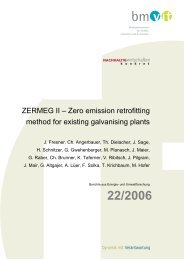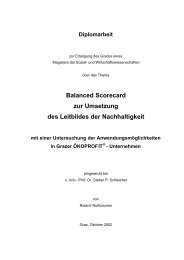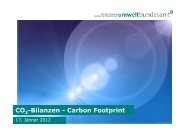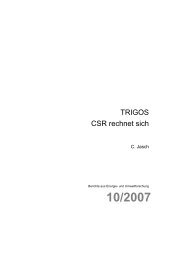Promoting Resource Efficiency in Small & Medium size ... - UNEP
Promoting Resource Efficiency in Small & Medium size ... - UNEP
Promoting Resource Efficiency in Small & Medium size ... - UNEP
Create successful ePaper yourself
Turn your PDF publications into a flip-book with our unique Google optimized e-Paper software.
Step 1: Collect data<br />
The prime objective of energy efficiency is to create the company’s product<br />
or service with the m<strong>in</strong>imum energy <strong>in</strong>put. Therefore, this background<br />
<strong>in</strong>formation focuses on the energy service and not on the use of energy.<br />
Electricity meters (power clamps) help to meter electricity consumption<br />
of <strong>in</strong>dividual power consum<strong>in</strong>g equipment. This will help to break down<br />
the overall daily or weekly consumption that is taken from the electricity<br />
meters.<br />
Data on the annual consumption as well as costs have to be collected<br />
separately for each type of energy source. These data are available on<br />
energy bills (electricity, district heat<strong>in</strong>g, gas) or from suppliers of heat<strong>in</strong>g<br />
oil or diesel as well as <strong>in</strong> records of the <strong>in</strong>-company petrol station or<br />
electricity plant, etc. Peak loads and power factor are additional relevant<br />
<strong>in</strong>formation that will have an impact on the electricity bill.<br />
Every company should strive to reduce its energy consumption. For<br />
expand<strong>in</strong>g companies, trend charts are the most reliable <strong>in</strong>dicator of<br />
energy efficiency, whereas overall energy consumption is not as tell<strong>in</strong>g.<br />
Step 2: Draw-up a list of equipment<br />
Draw<strong>in</strong>g up a list of company equipment with respective consumption<br />
data will show which equipment is responsible for what energy use. Use<br />
this <strong>in</strong>formation to bra<strong>in</strong>storm improvement options.<br />
Step 3: Record data<br />
Based on specific energy consumption, the energy situation <strong>in</strong> a<br />
company can be analysed and controlled. In this case, the follow<strong>in</strong>g<br />
po<strong>in</strong>ts have to be considered:<br />
• Has specific energy consumption <strong>in</strong>creased?<br />
– What could be the reason? Which areas have expanded?<br />
Has this expansion caused the higher specific energy<br />
consumption? Have energy sources been substituted?<br />
• If the specific energy consumption has decreased:<br />
– Is the decrease due to specific energy sav<strong>in</strong>g measures?<br />
Have the targets been met? Has the consumption decreased<br />
because energy sources were substituted?<br />
• Where can I f<strong>in</strong>d appropriate benchmarks?<br />
– Ask colleagues for data from a particular sector<br />
– Ask plant manufacturers for data<br />
– Search <strong>in</strong> literature (Chapter 9 of this manual and research<br />
journals)<br />
Carry out <strong>in</strong>-house calculations (calculate the efficiency boiler,<br />
efficiency of air compressor, heat losses from <strong>in</strong>sulation us<strong>in</strong>g the<br />
respective worksheets <strong>in</strong> the electronic version of the toolkit).<br />
To do this, measurements from your facility will be most helpful.<br />
Simple handheld thermometers can help to quickly get an idea of the<br />
temperatures of products, steam, condensate, water and refrigerants.<br />
Figure 32: A digital power clamp 42<br />
If the monthly consumption data are put together, they will form an<br />
annual consumption profile, from which the follow<strong>in</strong>g conclusions can<br />
be drawn:<br />
• Determ<strong>in</strong>ation of the w<strong>in</strong>ter-summer ratio to estimate the<br />
percentage of energy required for heat<strong>in</strong>g, cool<strong>in</strong>g and process<br />
heat<br />
• Results achieved by the substitution of energy carriers, for<br />
<strong>in</strong>stance if heat<strong>in</strong>g oil was substituted by electricity, etc. (<strong>in</strong> this<br />
case, several years need to be taken <strong>in</strong>to account)<br />
• Possibility of analys<strong>in</strong>g energy carriers, e.g. for comb<strong>in</strong>ed heat<br />
and power generation<br />
• Determ<strong>in</strong>ation of months with significant consumption peaks<br />
and measures to avoid them<br />
The respective data can be taken from energy supplier bills and the<br />
company records.<br />
Step 4: Benchmark consumption<br />
For the evaluation of a company’s energy consumption, key<br />
performance <strong>in</strong>dicators are valuable . For <strong>in</strong>stance, <strong>in</strong> the case of a<br />
brewery, an <strong>in</strong>dicator can be the fuel oil consumption per hectolitre of<br />
beer. These reference values can differ substantially depend<strong>in</strong>g on the<br />
type of energy or the characteristics of the company. Typical reference<br />
values are production volume, turnover, number of staff, heated surface,<br />
transported volume, mileage, etc.<br />
Some benchmarks are <strong>in</strong>cluded <strong>in</strong> Chapter 9 of this manual. Please go<br />
to the Virtual Assessment section of the electronic toolkit for detailed<br />
sector and unit specific benchmarks.<br />
Figure 31: Us<strong>in</strong>g a simple laser thermometer 41<br />
Step 5: Record load profile and analyse<br />
Before consider<strong>in</strong>g methods of load management, some terms used <strong>in</strong><br />
connection with power supply need to be def<strong>in</strong>ed.<br />
41) J. Fresner, own picture<br />
42) FLUKE, 2010<br />
48
















